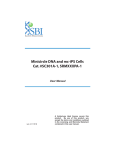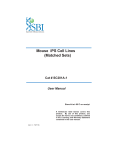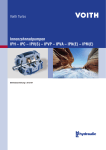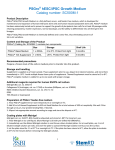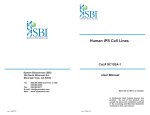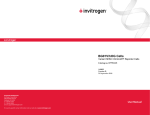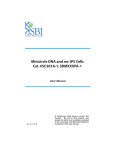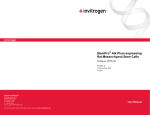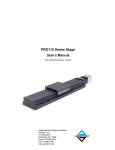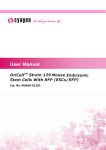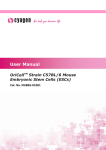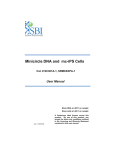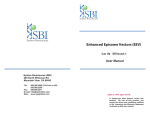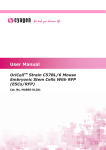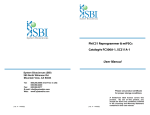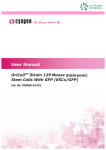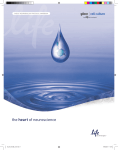Download piPS Cells Cat. #SC801A-1 & SC802A-1
Transcript
piPS Cells Cat. #SC801A-1 & SC802A-1 User Manual Store cells in liquid nitrogen ver. 1-021111 A limited-use label license covers this product. By use of this product, you accept the terms and conditions outlined in the Licensing and Warranty Statement contained in this user manual. piPS Cells Cats. # SC801A-1, SC802A-1 Contents I. Introduction and Background ..................................................2 A. Evolution of Reprogramming Technology ...........................2 B. Protein derived iPS cell line ................................................3 II. Protocols .................................................................................5 A. Materials..............................................................................5 Gelatin treatment of plates ..............................................................7 Thawing MEF cells ..........................................................................7 Thawing human iPS cells................................................................9 III. References ........................................................................12 IV. Technical Support .............................................................13 V. Licensing and Warranty ........................................................13 888-266-5066 (Toll Free) 650-968-2200 (outside US) Page 1 System Biosciences (SBI) I. User Manual Introduction and Background A. Evolution of Reprogramming Technology The concept of reprogramming was initially demonstrated by Gurdon et al. in 1958, where they generated adult Xenopus from somatic cells by nuclear reprogramming. After the discovery of induced pluripotent stem cells, iPSC technique using defined transcription factors has been a basis and standard for generation of pluripotent stem cells. In comparison to somatic cell nuclear transfer, the iPSC technology offers an unprecedented technical simplicity and enables generation of patient-specific pluripotent stem cells with less ethical concerns. Although iPSC technology provides unprecedented opportunities in biomedical research and regenerative medicine, there remains a great deal to learn about iPSC safety, the reprogramming mechanisms, the quality of iPSCs from different source cells and the variations using different reprogramming technology. Since 2006, iPSC technology has evolved from integrated virus (Retrovirus and lentivirus) to non-integrated virus (Adenovirus) viral methods, to non-viral methods (plasmids), genetic methods (DNA or RNA vectors) to non-genetic methods (proteins). These technical advances provide safer iPSCs for more meaningful mechanistic studies, iPSC-based disease modeling, and drug screening. Year 2006 Page 2 Present ver. 1-020711 www.systembio.com piPS Cells Cats. # SC801A-1, SC802A-1 B. Protein derived iPS cell line SBI offers the human protein iPS cell lines highlighted in Cell Stem Cell, Generation of Human Induced Pluripotent Stem Cells by Direct Delivery of Reprogramming Proteins. Kim D, et al., 2009, 4:472-476. The piPS cell lines were derived from the most commonly used source cells, newborn human fibroblasts. To date, all methods to generate iPSCs require the use of genetic materials and/or potentially mutagenic chemicals. Using protein engineering technology, stable piPSCs were induced from human fibroblasts by directly delivering four reprogramming proteins (Oct4, Sox2, Klf4, and c-Myc) fused with a cell-penetrating peptide. These piPSCs exhibited similarities to human embryonic stem cells in morphology, proliferation, global gene expression, DNA methylation patterns, and expression of characteristic pluripotency markers. PiPSC lines produced with recombinant proteins were successfully maintained for more than 35 passages and differentiated into derivatives of all three embryonic germ layers during the formation of embryoid body (in vitro) and teratomas (in vivo), the most stringent tests for the quality of human iPS cells. This protein reprogramming system eliminates the potential risks associated with the viruses, DNA transfection, and potentially harmful chemicals. Therefore, it provides a promising safe source of patient-specific cells for the future regenerative medicine. 888-266-5066 (Toll Free) 650-968-2200 (outside US) Page 3 System Biosciences (SBI) Page 4 User Manual ver. 1-020711 www.systembio.com piPS Cells Cats. # SC801A-1, SC802A-1 II. Protocols A. Materials Human ESC medium Component Knockout serum replacement Glutamax-1 Nonessential amino acid 2-mercaptoethanol penicillin and streptomycin bFGF KO DMEM/F12 Cat. # Final concentration Source 10828028 20% Invitrogen 35050061 2 mM 11140050 M7522 15140122 233-FB025 12660012 Invitrogen -4 Invitrogen -4 1 x 10 M 50 U and 50 µg /ml Sigma 10 ng/ml R&D 1 x 10 M Invitrogen Invitrogen MEF medium Component Cat. # FBS 16000077 Glutamax-1 penicillin and streptomycin DMEM 35050061 888-266-5066 (Toll Free) 15140122 Final concentration 10% 2 mM 50 U and 50 µg /ml 11995065 650-968-2200 (outside US) Source Invitrogen Invitrogen Invitrogen Invitrogen Page 5 System Biosciences (SBI) User Manual Other Required Reagents Component Cat. # Final concentration Source Rock Inhibitor Y27632 Y0503 10 µM/ml Sigma G1890 Dissolve 0.5 g of gelatin from porcine skin in 500 ml DPBS and autoclave. Stable for 1 yr at room temperature Sigma SCR005 Aliquot in 10 ml and store in -20°C. Dilute 1:1 with DPBS before use. Millipore 0.1% (w/v) Gelatin Accutase Human ES freezing medium 90% FBS plus 10% DMSO, with 10 µM ROCK inhibitor Y-27632 NOTE: This protocol is for growing piPS cells on MEF feeder cells. These should already be growing before you plate your piPS cells. Page 6 ver. 1-020711 www.systembio.com piPS Cells Cats. # SC801A-1, SC802A-1 B. Protocol for Human iPS Cell Culture Growth condition for mouse fibroblasts (for feeder layers) Gelatin treatment of plates 1. Add enough sterile/autoclaved 0.1% gelatin to cover the bottom of the wells. Approximate amounts: 10cm - 5ml 6 well - 1.5ml/well 24 well - 0.5 ml/well 96 well - 200 µl/well 2. Incubate the gelatin-coated dishes for at least 15 min at 37 °C. 3. Aspirate excess gelatin solution before using. Thawing MEF cells To insure the highest level of viability, be sure to warm medium to 37 °C before using it on the cells. Cells should be plated at a minimum cell density of 1 x 104 cells/cm2. 1. Remove the vial from liquid nitrogen and thaw quickly in 37 °C water bath. 2. Remove the vial from the water bath as soon as the cells are half way thawed, and sterilize by spraying with 70% ethanol. 3. Transfer the cells with 10 ml of MEF medium to a 15-cm conical tube and pellet the cells by centrifugation at 200x g for 5 min. 4. Discard the supernatant and resuspend the cells with 10 ml fresh MEF medium and plate the cells at seed density of 1 x 104 cells/cm2. 888-266-5066 (Toll Free) 650-968-2200 (outside US) Page 7 System Biosciences (SBI) User Manual 5. Incubate at 37 °C with 5% CO2 in air atmosphere, until the cells reach 80-90% confluency. 6. Change medium twice a week or when pH decreases. Passage of MEF cells Cells should be split when they reach confluency. A split based on seed density of 0.5 x 104 cells /cm2 is recommended. 1. Discard the medium and wash the cells twice with PBS. 2. Aspirate PBS, and add 1 ml per T75 flask of 0.25% trypsin-EDTA, and incubate for 1 min. 3. Add 5 ml of MEF medium, and break up the cell clumps by gently pipetting up and down several times. 4. Transfer cells into a conical tube and centrifuge at 200 g for 5 min. 5. Discard the supernatant, and resuspend the cell pellet in 10 ml MEF medium. 6. Count the number of cells, plate cells at 0.5 x 104 cells/cm2, and incubate at 37 °C with 5% CO2. Freezing MEF cells 1. Follow steps 1-4 from the Passage of Cells above. 2. Discard the supernatant, and resuspend the pellet in MEF medium. Add approximately 1 ml for each T75 flask. 3. Count the number of cells and dilute the cell suspension to 1 x 107 cells/ml. 4. Add an equal volume of cold 2X Freezing Media (containing 20% DMSO and 80% FBS) to the cell suspension. 5. Aliquot 1 ml of suspension into each cryovial (5 x 106 cells/vial). Page 8 ver. 1-020711 www.systembio.com piPS Cells Cats. # SC801A-1, SC802A-1 6. Place the vials in a cell-freezing container and keep it at 80 °C overnight. 7. Transfer the vials to a liquid nitrogen tank for long-term storage. Mitomycin C treatment of MEF At confluence, MEF cells are treated with mitomycin C to halt the division of the cells when they are still able to condition the medium as the feeder layers for human iPS cells. 1. Add 6 mL of fresh MEF medium containing 50 μl of mitomycin C solution (1mg/ml) to one T75 flask of confluent MEF cells, and swirl it briefly. 2. Incubate at 37 °C for at least 3 h. 3. After incubation, aspirate the mitomycin C-containing medium off the cells, and wash the cells twice with 10 ml of PBS. 4. Aspirate off PBS, add 1 ml of 0.25% trypsin-EDTA, swirl to cover the entire surface, and incubate for 1 min at room temperature. 5. Add 5 ml of MEF medium, and break up the cells to a single cell suspension by pipetting up and down. Count the number of cells. Seed the cells on gelatin-coated 6 5 dishes (1x 10 cells per 100-mm dish, or 1.5 x 10 cells per well of 6-well plate). 6. Cells should be ready to use by the next day. Growth condition for human iPS cells Thawing human iPS cells To insure the highest level of viability, be sure to warm medium to 37 °C before using it on the cells. Due to the low survival rate of cryopreserved human iPS cells, the recovery is expected to take at least one week. 888-266-5066 (Toll Free) 650-968-2200 (outside US) Page 9 System Biosciences (SBI) User Manual 1. Remove the vial from liquid nitrogen and thaw quickly in 37 °C water bath. 2. Remove the vial from the water bath as soon as the cells are half way thawed, and sterilize by spraying with 70% ethanol. 3. Transfer the cells with 10 ml of human ES medium to a 15-cm conical tube and pellet the cells by centrifugation at 200x g for 5 min. 4. While centrifuging, remove MEF medium from the 6-well plate with MEF feeder cells, wash the well twice with 1 ml of KO DMEM/F12, and add 1 ml of human ES medium supplemented with ROCK inhibitor Y-27632 (10 µM). 5. Discard the supernatant of the tube containing human iPS cells, resuspend the cells with 1 ml of fresh human ES medium with ROCK inhibitor Y-27632, and plate the cells in the wells of 6-well plate with MEF feeder cells. 6. Incubate at 37 °C with 5% CO2 in air atmosphere, until the cells reach 80% confluency. 7. Change the medium everyday. Note: Y-27632 is not necessary for regular human iPS cell culture. Maintenance of human iPS cells It is important to note that do NOT keep human iPS cells in culture for long periods in order to maintain the pluripotency. 1. Aspirate the medium, and wash the cells twice with 1 ml of PBS. 2. Remove PBS completely, add 0.5 ml of 1:1 Accutase to each well of a 6-well plate, and incubate at room temperature for 1 min. 3. While incubating, remove a 6-well plate with MEF feeder cells from the incubator. Aspirate MEF medium, wash with 1 ml of KO DMEM/F12 twice for each well, and add 1 ml of human ES medium with 10 µM ROCK inhibitor to each well. Page 10 ver. 1-020711 www.systembio.com piPS Cells Cats. # SC801A-1, SC802A-1 4. When the edge of the human iPS cell colonies have fold up, aspirate the Accutase solution and wash the cells three times with DMEM/F12 medium. 5. Add 1 ml per well of human ES medium, and dislodge the cell colonies by using cell scraper. 6. Transfer the contents into a 15 ml conical tube with 5 ml of pre-warmed human ES medium. Use another 1 ml of medium to wash the well one more time and combine it to the same tube. 7. Centrifuge at 200x g for 5 minutes at room temperature. 8. Carefully aspirate the overlaying medium, then gently finger tap the tube bottom to dislodge the cell pellet. 9. Gently add 3 to 6 ml of fresh human ES medium with 10 µM ROCK inhibitor, and resuspend the cells by gently pipetting up and down. 10. Add 1 ml of the human iPS cell suspension to each well of the 6-well plate. Right after plating iPS cells, gently swirl the plate back-and-forth and side-to-side to evenly distribute the cells, and incubate at 37°C. 11. The ES media must be changed every day and human iPS cells sub-cultured every 5-7 days when the undifferentiated colonies are big enough. Track passage number of iPS cells. Note: human iPS cells could also be grown on HFF feeders. Freezing human iPS cells 1. Grow human iPS cells to the exponential phase in a 6-well plate, and pre-treat cells with 10 µM Y-27632 for one hour prior to freeze. 2. Remove PBS completely, add 0.5 ml of 1:1 Accutase, and incubate at room temperature for 1 min. 888-266-5066 (Toll Free) 650-968-2200 (outside US) Page 11 System Biosciences (SBI) User Manual 3. While incubating, remove a 6-well plate with MEF feeder cells from the incubator. Aspirate MEF medium, wash with 1 ml of KO DMEM/F12 twice for each well, and add 1 ml of human ES medium to each well. 4. When the edge of the human iPS cell colonies fold up, aspirate Accutase solution and wash the cells three times with KO DMEM/F12 medium. 5. Add 1 ml per well of human ES medium, and dislodge the cell colonies using cell scraper. 6. Transfer the contents into a 15 ml conical tube with 5 ml of pre-warmed human ES medium. Use another 1 ml of medium to wash the well one more time and combine it to the same tube. 7. Centrifuge at 200x g for 5 minutes at room temperature. 8. Carefully aspirate the overlaying supernatant, then gently finger tap the tube bottom to dislodge the cell pellet. 9. Gently add 2 ml of human ES freezing medium supplemented with 10 µM Y-27632, resuspend the cells by gently pipetting up and down, and aliquot it at 1 ml per vial. 10. Put the vials in a cell-freezing container, and store the vials at –80°C overnight. 11. Transfer the vials to liquid nitrogen for long-term storage. III. References Kim D et al., Generation of Human Induced Pluripotent Stem Cells by Direct Delivery of Reprogramming Proteins. Cell Stem Cell. 2009; 4:472-476. Fangjun Jia et al. A nonviral minicircle vector for deriving human iPS cells. Nature Methods 2010;7(3):197-9. Page 12 ver. 1-020711 www.systembio.com piPS Cells Cats. # SC801A-1, SC802A-1 IV. Technical Support For more information about SBI products and to download manuals in PDF format, please visit our web site: http://www.systembio.com For additional information or technical assistance, please call or email us at: Phone: (650) 968-2200 (888) 266-5066 (Toll Free) Fax: (650) 968-2277 E-mail: General Information: [email protected] Technical Support: [email protected] Ordering Information: [email protected] System Biosciences (SBI) 265 North Whisman Road Mountain View, CA 94043 V. Licensing and Warranty Use of the P-iPS cell lines (i.e., the “Product”) is subject to the following terms and conditions. If the terms and conditions are not acceptable, return all components of the Product to System Biosciences (SBI) within 7 calendar days. Purchase and use of any part of the Product constitutes acceptance of the above terms. The purchaser of the Product is granted a limited license to use the Product under the following terms and conditions: The Product shall be used by the purchaser for internal research purposes only. The Product is expressly not designed, intended, 888-266-5066 (Toll Free) 650-968-2200 (outside US) Page 13 System Biosciences (SBI) User Manual or warranted for use in humans or for therapeutic or diagnostic use. The Product may not be resold, modified for resale, or used to manufacture commercial products without prior written consent of SBI. This Product should be used in accordance with the NIH guidelines developed for recombinant DNA and genetic research. ** This Product shall be used by the purchaser for internal research purposes only and distribution is strictly prohibited without written permission by System Biosciences. Limited Warranty SBI warrants that the Product meets the specifications described in the accompanying Product Analysis Certificate. If it is proven to the satisfaction of SBI that the Product fails to meet these specifications, SBI will replace the Product or provide the purchaser with a refund. This limited warranty shall not extend to anyone other than the original purchaser of the Product. Notice of nonconforming products must be made to SBI within 30 days of receipt of the Product. SBI’s liability is expressly limited to replacement of Product or a refund limited to the actual purchase price. SBI’s liability does not extend to any damages arising from use or improper use of the Product, or losses associated with the use of additional materials or reagents. This limited warranty is the sole and exclusive warranty. SBI does not provide any other warranties of any kind, expressed or implied, including the merchantability or fitness of the Product for a particular purpose. SBI is committed to providing our customers with high-quality products. If you should have any questions or concerns about any SBI products, please contact us at (888) 266-5066. © 2011 System Biosciences (SBI), All Rights Reserved. Page 14 ver. 1-020711 www.systembio.com
















